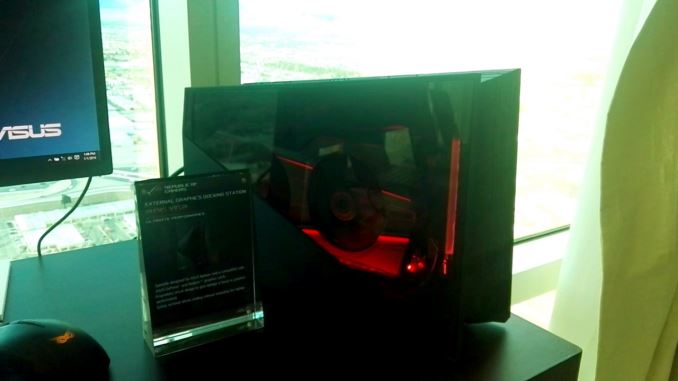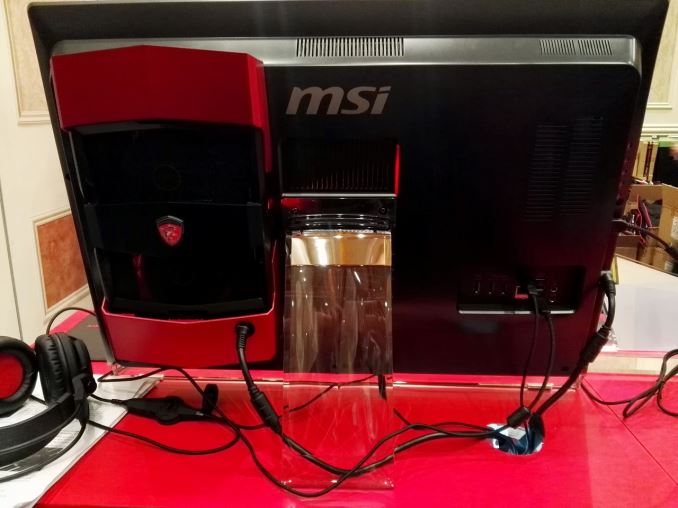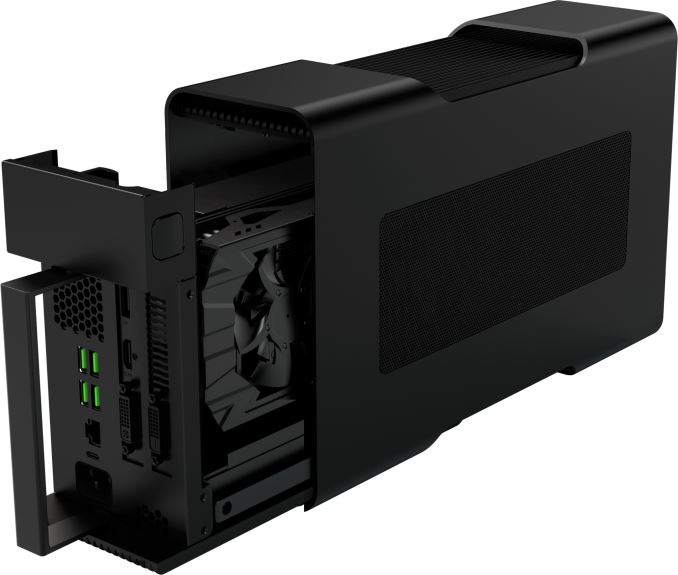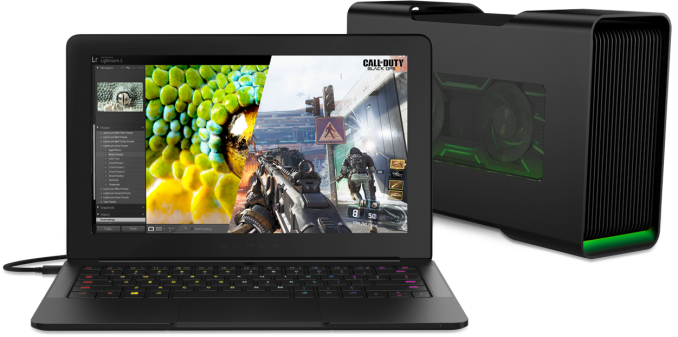CES 2016 Roundup: Total Editor Recall
by AnandTech Staff on January 26, 2016 11:00 AM EST- Posted in
- Trade Shows
- CES 2016
News Editor, Anton Shilov
There are several things that people want from their personal computers these days: mobility, high-resolution display, high performance across a wide range of applications (including demanding PC games), sleek design and some require a small form-factor setup. While it is possible to get an ultra-thin laptop, a powerful desktop and a high resolution monitor, it is pretty hard to get everything in one package. Apparently, companies like ASUS, MSI and Razer know a way how to partly solve the problem, and we saw their solutions at CES.
Modern microprocessors and solid-state drive can offer desktop-class performance on an ultra-thin notebook. However, when it comes to performance in graphics-intensive applications, it is simply impossible to build a leading-edge GPU, which is required to play the latest games in ultra-HD (4K) resolution, into an ultra-slim form-factor system. As modern GPUs can dissipate 300W of heat, it is impossible to cool-down such a chip in a laptop. Moreover, even a 100W GPU will completely ruin battery life and will require a sophisticated cooling solution, which means a thicker design. The only way to enable proper graphics performance on a small form-factor PC is to use an external graphics adapter. While some may argue that external graphics solutions are only useful for a fraction of the market, this is not entirely true. In addition to notebooks, external graphics adapters could be plugged to small form-factor PCs like Intel NUC or all-in-one systems with decent displays, which are expanding in their utility, particularly in enterprise and other global markets.
External graphics adapters are not something new. Back in 2007/2008 AMD introduced its external graphics port (XGP) technology, code-named Lasso. AMD’s XGP allowed to connect a graphics card to a PC using the PCIe 2.0 x8 or x16 interface, which guaranteed sufficient amount of bandwidth for the time. Unfortunately, the XGP relied on a sophisticated proprietary connector that was made by only one company and was rather expensive. As a result, it never took off.
ASUS, Alienware, MSI and some other companies have also introduced external graphics solutions for their mobile PCs over the past decade. However, their GPU boxes were either proprietary, or had performance limitations. For example, ASUS’ first-generation XG Station contained an NVIDIA GeForce 8600 GT GPU and used Express Card interface, providing rather low performance even for 2007. More recently, Alienware and MSI introduced proprietary external graphics solutions compatible only with their laptops. The GPUs relied on external PCIe x4 interface, they were compatible with rather powerful video cards (thanks to the fact that they featured their own PSUs) and hence could really bring serious performance improvements. Unfortunately, both Alienware’s Graphics Amplifier as well as MSI’s Gaming Dock were only compatible with select laptops made by these two companies.
At CES 2016 several companies introduced their new external GPU boxes that can accommodate high-end graphics adapters. At least one of the solutions uses Thunderbolt 3 interface with up to 40 Gb/s transfer rate and are compatible with various PCs. Some continue to be proprietary, but are using more modern connectors such as USB Type-C. However, since they can offer desktop performance, they can help to build gaming systems based on ultra-thin notebooks, AIO or SFF desktops.
ASUS was among the first hardware makers to offer external graphics solutions for laptops in the mid-2000s and at CES 2016 it demonstrated its all-new XG Station 2, which is designed for the company’s upcoming notebooks. The XG Station 2 is compatible with any ASUS video card based on AMD Radeon or NVIDIA GeForce GPU that consumes up to 350W of power, which means that you can install almost any board into this dock. The XG Station 2 uses two USB type-C cables that support up to 32 Gb/s transfer rates (which is equivalent to PCIe 3.0 x4), but relies on a proprietary architecture. The external GPU kit from ASUS seems to be a powerful solution and it even allows using the laptop’s own display to play games using external video cards. However, since it is a proprietary technology, it will not be compatible with non-ASUS systems.
The manufacturer did not reveal a lot of information about its plans concerning the XG Station 2 and compatible laptops. Hence, it is unknown how competitive ASUS’ solutions with external graphics will be. Nonetheless, it is a good thing to know that the world’s largest supplier of gaming laptops intends to offer external GPUs as an option.
MSI already offers Gaming Docks for select laptops. At CES 2016 the company demonstrated its external graphics solution for its all-in-one gaming PCs. The external GPU dock for AIO systems is compatible only with the company’s 27XT 6QE as well as NVIDIA graphics cards, but it uses PCI Express interconnection and can house almost any contemporary GeForce (with exception of dual-GPU cards and some non-reference boards). The solution looks like a commercial one and it will, without any doubts, become a key selling point of MSI’s gaming AIOs this year.
The form-factor of the dock is tailored for all-in-one PCs, hence, it cannot be easily connected to laptops or SFF systems. Moreover, since implementation of the PCI Express and GPU power delivery are clearly proprietary, MSI’s external graphics boxes will only be compatible with its own AIOs. Keeping in mind that MSI needs to sell system to gamers, even proprietary external GPU box makes a great sense for the company as it allows is to offer almost any video card with its AIOs, unlike other PC makers.
Razer, which is mostly known for its peripherals and gaming laptops, decided not to use any proprietary technologies with its new Razer Stealth ultrabook and Razer Core external GPU dock. Everything is based on industry-standard components and hence the Core can be connected to almost any system with Thunderbolt 3.
Unlike ASUS and MSI, which are still finalizing their new external GPU technologies, Razer is already taking pre-orders on the Stealth notebook. The Stealth laptop is just 0.52-inches thick, but it features a 12.5-inch IGZO display with 2560x1440 or even 3840x2160 resolution as well as the Intel Core i7-6500U central processing unit. The system can be equipped with up to 8 GB of LPDDR3-1866 memory, up to 512 GB of PCIe SSD, 802.11ac Wi-Fi, built-in webcam and so on. The laptop starts at $999, which is comparable to other ultrabooks.
They Razer Core is an external GPU box that connects to personal computers using Thunderbolt 3 interface with up to 40 Gb/s transfer rate (appropriate cable is included). The enclosure features its own 500 W PSU and is compatible with all graphics cards with up to 375 W TDP. The GPU box also features four additional USB 3.0 ports as well as a Gigabit Ethernet controller.
Razer does not sell its Core GPU box just yet, hence, the pricing is unknown. Nonetheless, its reliance on Thunderbolt 3 technology and compatibility with a variety of laptops and SFF PCs makes it a very interesting product. If the company decides not to artificially limit compatibility of its Core with third-party PCs, the external GPU box can become a rather powerful product among owners of notebooks and SFF PCs with Thunderbolt 3 interconnection.
The general industrial trends show that modern PCs are becoming smaller and sleeker, but high-end graphics adapters remain rather large and power hungry. As a result, external graphics solutions for mobile and small form-factor personal computers are just what the doctor ordered. However, proprietary solutions are not always good, especially if we are talking about systems from smaller suppliers or the desire to be 'truly' universal. That being said, locking a user into a certain methodology might guarantee future sales. But Thunderbolt 3-based external GPU boxes look very promising because they combine relatively high transfer rates with simplicity and industry-standard cables (which means relatively affordable pricing).
In fact, after seeing Razer’s Core, it becomes pretty clear that after a decade in development, I think external graphics is on its way to finally done right.

















44 Comments
View All Comments
ingwe - Tuesday, January 26, 2016 - link
This article was a really cool idea. I enjoyed reading it.codylee - Thursday, January 28, 2016 - link
I agree, Great way to write the roundup! VR + External graphics dock looks to be most exciting!hojnikb - Tuesday, January 26, 2016 - link
>but Mushkin is expecting to be able to ship the 4TB model for a mere $500, which will greatly help it find a niche.thats actually not true. this drive is gonna cost 2k$
Ian Cutress - Tuesday, January 26, 2016 - link
We were told $500 direct from Mushkin in our meeting with them, and other sites are reporting $500 as well. Google search 'Mushkin 4TB 500'. Unless you have other information...?MikhailT - Tuesday, January 26, 2016 - link
Please provide your source for this. All of the press were told by Mushkin directly that it will be around 500$.hojnikb - Tuesday, January 26, 2016 - link
They later correted this and said its gonna be 2000$Its kinda too good to be true, that a nieche product with two controllers and 4TB of flash would be that cheap.
hojnikb - Tuesday, January 26, 2016 - link
Correction, its actually gonna be close to 1000$. They specifically said its gonna be targeted at 0.25$/GB, which equals to 1k$Billy Tallis - Tuesday, January 26, 2016 - link
The current Reactor with planar NAND is at $0.25/GB already. The 3D NAND transition should mean that large drives (where the controller costs are a small portion of the total BOM) will be significantly below that price point once production is at full capacity.Kristian Vättö - Tuesday, January 26, 2016 - link
But the 4TB drive is dual-controller with a hardware RAID controller, so the price should be at least twice compared to the 2TB single controller version. From what I heard from Chris Ramseyer at Tom's, the target price for the 2TB model is $0.25/GB, whereas the pricing of the 4TB is yet to be confirmed.Perhaps the long days (and nights) of CES resulted in Mushkin misspeaking about the pricing during meetings.
GTRagnarok - Tuesday, January 26, 2016 - link
Yeah, I didn't believe for one moment that we would get a 4TB SSD for $500 this year.